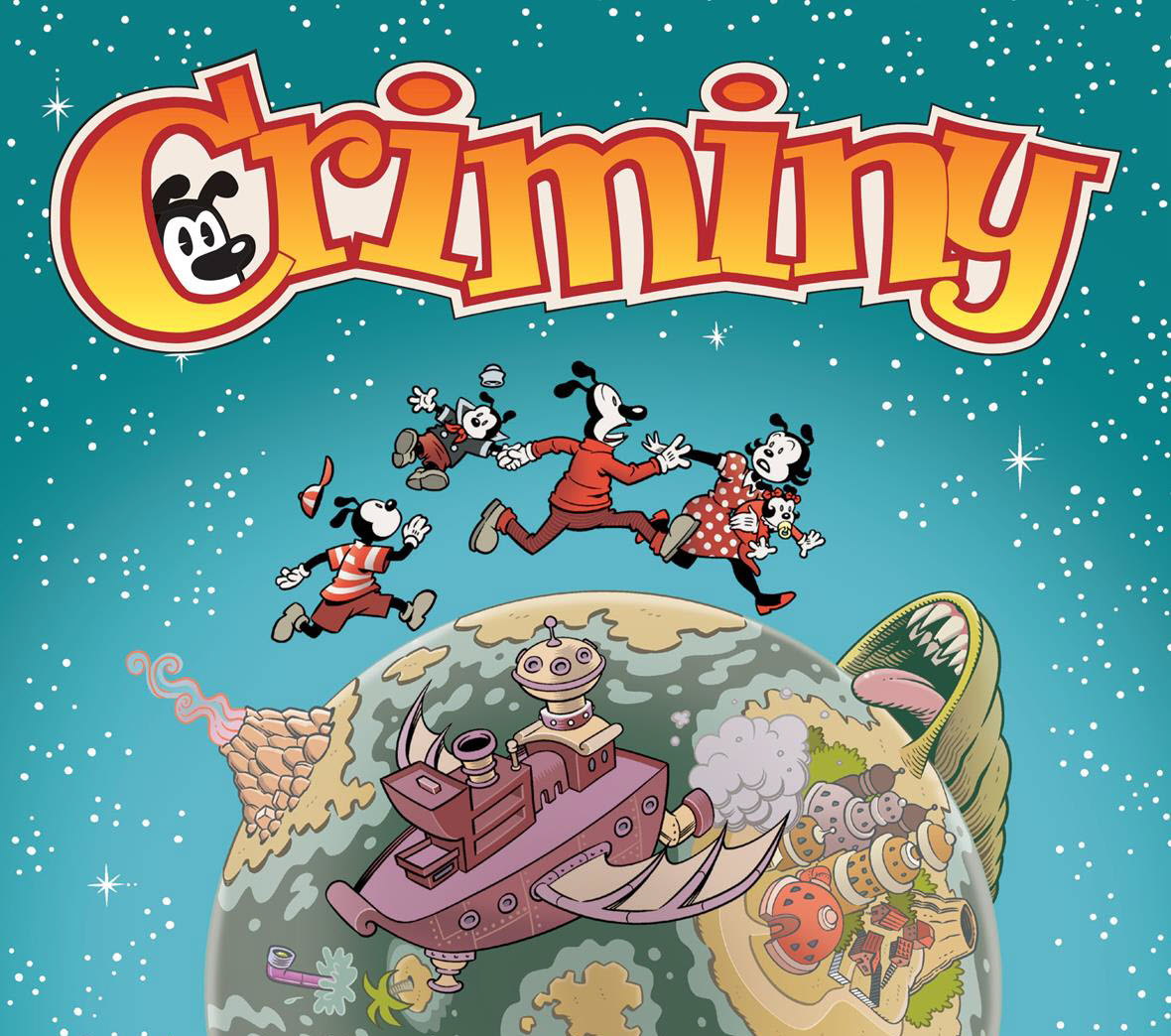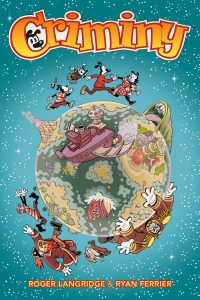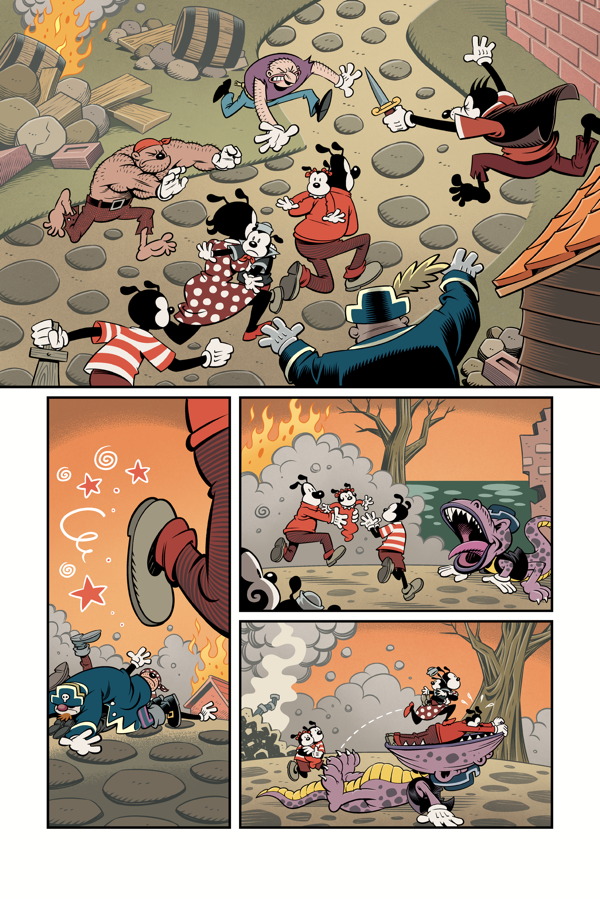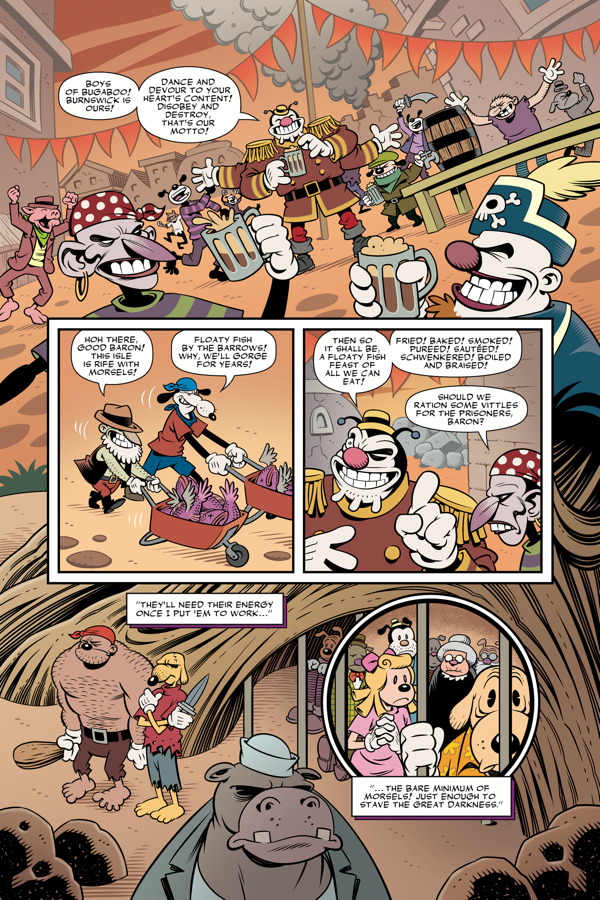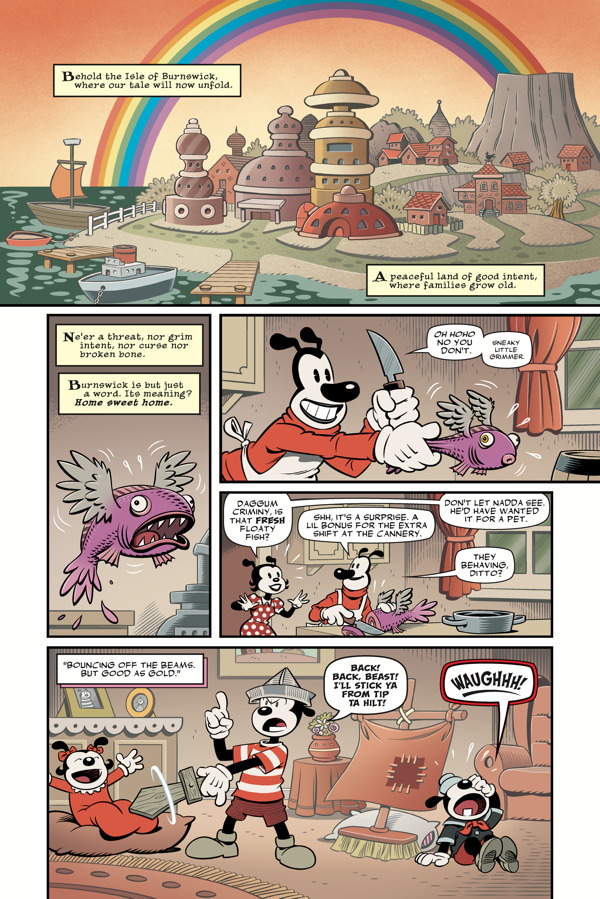Family drama. Pirates. Bizarre locales. Living skeletons. These are just a few of the things you’ll find in Criminy, the new graphic novel from artist Roger Langridge and writer Ryan Ferrier. The 96-page all-ages book features the creators channeling their inner Max Fleischer for an exciting adventure about the Criminy family as they try to reclaim their homeland, and the crazy characters they meet along the way. The book is wildly imaginative and entertaining for readers young and old, and we were fortunate to have the opportunity to chat with Langridge and Ferrier about Criminy‘s creation and influences.
Where did Criminy come from? How did the two of you develop the characters and the story?
Roger Langridge: The project grew out of a casual comment Ryan made on Twitter, to the effect that he had an idea for a story set in a Max Fleischer kind of world and wondered if there were any artists out there who might be interested in working on such a thing. I saw this, looked at my shelf of Popeye and Betty Boop comics and sent him a message, and things sort of developed from there. We had a period of back-and-forth where we worked up the core concepts, Ryan kicking things off with a list of his ideas and me working through some visual interpretations, some of which fed back into the story as they evolved into something else. It was a pleasantly organic sort of thing.
Ryan Ferrier: Like Roger noted, it was a bit of a chance encounter. Honestly, I knew the style I wanted to collaborate with before the concept was even born, and I remember tweeting that I was looking for an artist to work with and Roger—being a) one of my favorite artists ever, and b) the authority in that specific tone/style—had come into my mind immediately. To work with him was a total pipe dream, so imagine my surprise when he replied to me. I was, and still am, absolutely over the moon. From there, we kind of chipped away back and forth at the themes we wanted to touch on, and the story of the Criminy family came along quickly, and pretty smoothly.
I do a lot of that. pic.twitter.com/dFw2dCHehn
— Roger Langridge (@hotelfred) November 21, 2016
Thank you! You interest me strangely with your Fleischer talk. Would love to know more.
— Roger Langridge (@hotelfred) November 21, 2016
The book is an all-ages graphic novel, and it threads that needle really well. What challenges did you face in crafting a story that would appeal to both kids and adults?
Langridge: I’ve done a lot of stuff in this area in the past and I kind of know the territory. My big guiding light for this kind of work is Carl Barks, whose stories always seemed to be mainly about entertaining himself first and foremost; if you do that, and make sure you don’t get too violent or sweary and ensure everyone keeps their clothes on, you can’t go too far wrong.
Ferrier: I’m so chuffed to echo Roger’s example of Carl Barks, as I’m a massive fan of his work. I’m a firm believer that it is entirely possible to make an all-ages-appropriate story that doesn’t totally pander to one demographic; something a reader of any age can enjoy and dissect and relate to either together or independently. There is always a challenge, especially with some of the themes Criminy touches on, with going too dark or too serious, but that’s something we kept in the forefront of our mind and intentions throughout making the book—how can we touch on these relatively serious themes while still entertaining and keeping positive, without alienating any of our readers.
The story of the Criminys and their odyssey both away from and back to Burnswick is thrilling and scary, but there’s also great humor throughout the book. Was there a conscious effort made to balance those elements?
Langridge: Absolutely. If you’re trying to evoke the spirit of Max Fleischer, that blend of scariness and humour is intrinsic to the whole thing. Fleischer cartoons were set in a disturbing, fallen world, full of ghosts, speakeasies and urban decay. They’re really weird and unsettling! That feeling is kind of the grit in the oyster that makes those gag-filled fripperies into something memorable.
Ferrier: I’m a firm believer in rewarding a reader if they are taken on a journey of peril; otherwise, it’s just subjecting the audience to hardship without any reprieve. So leaning on humor was certainly a priority. Taking into account Roger’s beautiful artwork and the strange world we’ve built, it wasn’t exceptionally difficult beyond the usual challenges. I also like to think it’s because Roger and I have good senses of humor in general; there’s a bit of us both in our work. “Honest art,” as I always say.
Roger, the visuals in this book are incredible, and there’s a strong retro animation feel throughout. You both have already mentioned looking to Max Fleischer cartoons for inspiration. Were there any particular shorts you watched or other sources you turned to for inspiration in designing the characters and settings?
Langridge: Thank you! I’ve internalised a lot of this – as I mentioned, I’ve worked on Popeye and Betty Boop in the past, and some of my stories with my own character Fred the Clown are set in a Fleischeresque world as well, so I’ve had my toes in this particular pond for a couple of decades now. I watched some Betty Boop to get myself into the right frame of mind – Snow White has most of the elements I associate with classic Fleischer, and Bimbo’s Initiation is an amazing cartoon. Ryan put me on to one I’d never seen before called The Cobweb Hotel, which ticked a lot of boxes. There’s a whiff of Doctor Seuss in my designs for Burnswick as well, and the Grimmer Niff’s island took some inspiration from Pleasure Island, in Disney’s adaptation of Pinocchio.
It’s also mentioned in the back-matter of the book that you guys originally pitched the story as a miniseries. How did the story or the structure of the story change once it was decided to do the book as a graphic novel versus as a miniseries?
Ferrier: Yeah, we did initially pitch Criminy as a four-issue series, I believe. This is my second graphic novel, so I think my mind immediately just goes to single-issue series when putting together a pitch or a new project. But that’s certainly going to change, as I am now in love with the graphic novel format and can see that being a large part of my career. When Dark Horse gave us the green light with the new format, there was only a little bit of tinkering with the structure, but it was mostly freeing; now we didn’t really have to worry about the reader getting pieces of the overall story in monthly doses. I certainly re-examined the ebbs and flows of the entire structure, and as you’ll see in the book, it’s still broken into chapters.
Ryan, the rhyming narration you use throughout the book sets a tone for what readers are in for and helps maintain that tone throughout. How did you decide on using that form for the captions, and did it present any particular challenges as you worked on the book?
Ferrier: They poetry aspect of the book kind of fell into place; I created a poem as part of the pitch for Criminy, and once I got into scripting the book proper, I decided to lean into it more and use it as a tool to bookmark the chapters of the narrative. As someone who hasn’t written a lot of poetry, it certainly was challenging, but I’m really proud of that element. I think the poetry in the book is some of the best writing I’ve done, and I approached it all with a lot of heart. Again touching on the “reward from peril” aspect, I do think these chapter breaks allow for the reader to breathe a little bit before the next helping of action and excitement.
I really appreciated the tone of the book’s ending – without giving anything away, it’s an upbeat ending, but also decidedly not a ‘happily ever after’. Why do you think it was important to make that distinction?
Langridge: Ryan may have his own ideas about this, but to me the whole book is about the Criminy family’s perseverance against the odds, so that comes to define who they are to the reader. The suggestion that there are future challenges and that life goes on seems important to maintaining their identities.
Ferrier: Exactly what Roger said. It is a sobering ending, if anything. Throughout their journey, the Criminys—who are already at the start a close, loving family—realize they need each other to overcome the odds, and the importance of love. I think that part of not taking love an family for granted is a realistic sense of awareness; that home, no matter how idyllic, can be taken away at any moment.
Is this the last we’ve seen of the Criminys? Surely they’ve developed a taste for adventure by the book’s end.
Langridge: Speaking for myself, I would be delighted to return to the Criminys at some point. Not to spoil anything, but we see towards the end that they have at least one major development in their future, so that would be fun to explore. A lot of the heavy work of building their world has already been done now, so I’d love to poke around it a bit further.
Ferrier: I wouldn’t hesitate for one second to go on another adventure with our family. These characters are too good, and this world has only begun to be explored. I would love for people to enjoy Criminy enough for us to return to it all, absolutely.
Criminy is on sale now in comic shops, and will be available in the wider book market on October 2nd.


